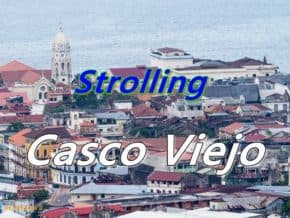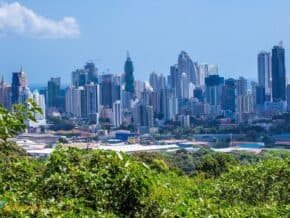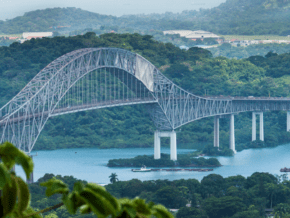When you visit Panama, make sure you carve out time for Panama Viejo. Lying on the seafront outskirts of city, Panama City, the ruins offer some fascinating insights into the country’s history.
ⓘ Panama Viejo means “Old Panama.” You’ll also hear it called Panama la Vieja (“Panama the Old”).

Why is Panama Viejo important?
Founded in 1519, Panamá Viejo is the oldest European settlement on the Pacific coast of the Americas. Conquistador Pedrarías Dávila laid it out using a rectilinear grid, and thus it was the first planned town in the Western Hemisphere.
The ruins were declared a UNESCO world heritage site in 1997 because the old city contains “an exceptional testimony of colonial town planning; while the ruins of its cathedral, convents and public buildings highlight the unique technological and stylistic characteristics”.
Bottom line: Recent excavations have resulted in valuable insights into colonial life at the height of Spanish imperial power. For historians, that’s a very big deal.
Why and when was Panama Viejo built?

Panama Viejo was founded while the Spanish were in the process of conquering South America. They needed a port on the Pacific side of the continent to collect all the gold and silver treasures they were looting from the Incas.
When it was built, it was simply called Panamá. Nothing old about it.
Anyway, once the Incan gold arrived in the city, mules brought it on the Camino Real, which was the cobbled road that connected Panamá to the Caribbean port of Portobelo. From there, everything was loaded onto Spanish galleons and shipped to Spain.
Who attacked Panamá Viejo, and why?

All that gold was way too tempting to ignore. On January 28, 1671, Captain Morgan attacked the city and wiped out the Spanish. Not wanting Morgan’s forces to occupy their city, the residents sacked it themselves and fled. Read more about the attack here.
Survivors built a new community on a peninsula not far away, which we now call Casco Viejo. (“Old Town.” Lol … that’s funny, isn’t it?)
ⓘ Morgan was arrested and charged, because his attack had violated a peace treaty between Spain and England. He was later released after proving he had been unaware of the treaty.
Why visit Panama Viejo

It may not look like it, but the entire Panamá Viejo Historical Monument Complex is huge: 57 acres. It’s the most funded archaeological site in the country.
When we first moved to the city in 2010, the ruins amounted to little more than a ticket booth, a fenced area around the tower and a dilapidated building where locals sold their crafts.
Since then, the entire area has been refurbished. Now, it’s one of the best tourist attractions in Panama City.
Hotels near Panama Viejo
Accommodation near Panama Viejo is hard to find, as this is a residential neighborhood. Of the three closest hotels, two are connected to ATLAPA Convention Center in Panama City, and the other is in Costa del Este, a nearby suburb.
Sheraton Grand Panama, a 4.5-star luxury resort that is 1.7 miles from Panama Viejo Museum. Connected to ATLAPA Convention Center, Sheraton Grand Panama offers a casino, onsite spa, three restaurants, a 24-hour health club, free WiFi, an outdoor pool, free parking, limo service, tennis courts, and express check-in/out.
Aloft Panama, a 3.5-star pet-friendly hotel that is 1.81 miles from Panama Viejo Museum. Aloft Panama offers a nightclub, poolside bar, terrace, an onsite restaurant, free in-room WiFi, a coffee shop/cafe, and dry cleaning/laundry services.
The Westin Panama, a 4-star property in Costa del Este, 2.12 miles from Panama Viejo Museum. Amenities include an onsite spa, bar, and restaurant, free Wi-Fi in public areas, a 24-hour gym and a business center.
Ruins of Panama la Vieja, the original Panama City

The Panama Viejo ruins cover a range of structures. You’ll find everything from the City Hall and cathedral, to a hospital, houses, shops, and religious buildings (churches, abbeys, and convents) for the Jesuits and Franciscans.
That said, the two best preserved structures are the convent and the old cathedral bell tower. While the tower was in use, it served double duty as a lookout tower.
Sure, you can see the buildings from outside of the fence, but it is worth buying a ticket to go in. Not only is there a great view from the tower, there are informational plaques all around the area that explain a lot more about the site.
We always enjoyed a relaxing walk through here, especially when the paths passed under the cool, leafy canopy. In such peaceful surroundings, it’s hard to imagine the mayhem that occurred when the city was actually being attacked and sacked by Captain Morgan.
If your knees can manage it, don’t miss a climb to the top of the 30-cathedral tower lookout. It’s a don’t-miss. You can easily see the tall buildings of Panama City from the top, as well as get a bird’s-eye view of the bits and pieces left of the old ruins.
ⓘ Note that for safety reasons, children younger than 8 years old cannot access the viewing tower.
Panama Viejo Museum

When you visit, it’s best to begin your visit at the museum. This will give you a better understanding of what you’re seeing when you visit the ruins.
The museum highlights the history of Panama Viejo
- from its original founding in the early 1500s
- to the attack and sack led by pirate/Captain Morgan (depends on who you ask!)
- to the eventual move from this location to Casco Viejo, about 10 km to the west.

Inside the museum, you’ll see interesting artifacts found during archaeological excavations, videos, photos, and other informative exhibits.
Our favorite thing at the museum was a mockup of what the city looked like in the 16th century. It had a huge main plaza, and avenues and streets following the same grid layout they were using in Europe at the time.
We’re not sure how large it was back then, but as many as 8000 people lived there in its heyday.
Panama Viejo shops

The shops are in the same area as the museum and are full of local color and flair. Even the building reflects the colorful tribes that were native to this land.
From hand carved figurines to stunning molas and Embera baskets, you can find what you want in practically every color.
You can be assured that all the crafts are handmade by local artisans.
FAQs about visiting Panama Viejo
What is Panama Viejo?
Panama Viejo is the oldest European settlement on the Pacific coast of the Americas. It was founded in 1519 by the conquistador Pedrarías Dávila.
What are the hours of operation?
Panama Viejo and its museum are open from 8:30 AM to 5:30 PM. The box office closes at 4:30 PM. Both facilities are closed on Mondays.
How much does it cost to enter?
The cost to enter Panama Viejo varies depending on nationality and age. Non-resident adults: $10; students: $5; children: $3. Panama residents pay a discounted rate ($5/$3/$2).
How much time to visit to Panama Viejo?
Panama Viejo’s grounds are extensive. It’s worth taking the time to walk the one mile (1.5 km) circuit around the complex. Plan on spending about two hours if you wish to see the ruins and visit the on-site museum. Add extra time if you’d like to shop for handicrafts.
What should I pack?
Panama is hot and its sun is strong, so don’t forget a hat, sunglasses, and comfortable shoes. Bring sunscreen and plenty of water.
Is it safe to visit Panama Viejo?
Panama Viejo is located in the Parque Lefevre neighborhood. It’s a poor neighborhood, but the complex is safe to visit.


Pin this to your travel board.





Lots of interesting history here and so great to know that they’re trying their best to preserve this gorgeous buildings (or what’s left of it).
Yes Noemi, they have done a tremendous job of preservation, even spending money to preserve an old bridge while fixing much needed traffic problems that Panama City used to be known for.
I love visiting ruins like this.That cathedral looks so big, it must have been a very impressive church. Hopefully they are going to restore some of these buildings to their initial glory. I didn’t know Panma Viejo was the first permanent European settlement in South America, that’s very interesting. You guys were very lucky to spend so much time in South America. I always wanted to visit Panama, but I only got to stop there in transit when we went to Argentina. Those woven baskets are kind of typical for the entire South America. I’ve seen them in Brazil and Argentina as well.
Thanks Anda, I don’t think they have any plans to rebuild that area of Panama City. They are however doing what they can to preserve the buildings and surroundings. Yes, by all means you should visit Panama and spend a few weeks in that great country. We are planning to take a few friends on a tour and they are excited to see the sights. Panama is a very diverse country with something to offer every taste. I truly hope you go.
You are so lucky to experience this place now before all the planned development is complete. It is the only issue with tourism sometimes the more popular a place becomes the more it looses a little of it’s soul.
Hi Sally, The cool thing is that the Panamanians have turned this into a tourist destination and thus the call to preserve the buildings, protect them from further damage and offer a visitor a good reason to learn about the history of Panama.
What a great find! I am not very familiar with Panama, so I didn’t even know there was a Panama Viejo. It looks gorgeous, and the ruins are fantastic. Definitely looks like a fun place to explore – hopefully, we’ll make it down there before too long! #TheWeeklyPostcard
Hello Rob, By all means you should make it to Panama. There are three distinctly different cities all part of the history of Panama City and Panama in general. Panama Viejo, Casco Viejo, and modern day Panama City all have great things to offer the interested visitor, from the ruins pictured to fine foods and wines, you just can’t go wrong in Panama.